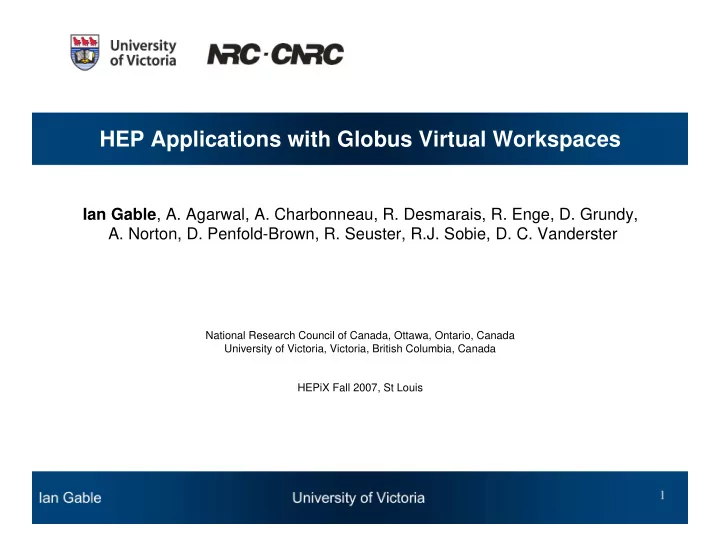

HEP Applications with Globus Virtual Workspaces Ian Gable , A. Agarwal, A. Charbonneau, R. Desmarais, R. Enge, D. Grundy, A. Norton, D. Penfold-Brown, R. Seuster, R.J. Sobie, D. C. Vanderster National Research Council of Canada, Ottawa, Ontario, Canada University of Victoria, Victoria, British Columbia, Canada HEPiX Fall 2007, St Louis 1 Ian Gable University of Victoria
Overview • Motivation • Virtual Machines on the Grid • Example Deployment • Results 2 Ian Gable University of Victoria
The Problem • In Canada we have computing resources we can’t use. Why? 3 Ian Gable University of Victoria
Virtualization on the Grid • Virtualization is the solution. • We can package an application complete with all of its dependencies and move it out to a remote resource. Virtual Machine Real Machine 4 Ian Gable University of Victoria
Virtualization for HEP Apps on the Grid • Find a virtual machine technology • Need a middleware • Movement of Images • Security 5 Ian Gable University of Victoria
VM: Xen is Useful for HEP • Xen is a Virtual Machine technology that offers negligible performance penalties unlike more familiar VM systems like VMware. • Xen uses a technique called “paravirtualization” to allow most instructions to run at their native speed. – The penalty is that you must run a modified OS kernel – Xen included in Linux Kernel mainline as of 2.6.23. • “Evaluation of Virtual Machines for HEP Grids”, Proceedings of CHEP 2006, Mumbai India. 6 Ian Gable University of Victoria
Before Globus Virtual Workspaces • We first tried developing our own in house solution for GridX1. • Set of simple Perl scripts to boot VMs on demand. • Not well integrated with middleware, non-standard interface. • Rewrite for every cluster. 7 Ian Gable University of Victoria
Security • Are you giving root away on your clusters? – root on domU != root on dom0 (not including recent Xen bugs). • Sandboxing – Globus Virtual Workspaces helps. VMs are booted on BEHALF of users. – Different networking sandbox strategies available. – We experimented successfully with each worknode NATing its virtual workernodes. • Authentication – Can you verify the source of your image? 8 Ian Gable University of Victoria
Image Signing First Steps • We need to verify that the images come from people we trust. – Signatures using grid certificates. – For VM we run a hash algorithm (sha1) on the image and sign the hash. • The group allowed to execute VMs doesn’t have to be the same as the group allowed to build them. Example: $ openssl x509 -in ~/.globus/usercert.pem -pubkey -noout > pubkey.pem $ openssl dgst -sha1 -sign ~/.globus/userkey.pem -out vm_image.sha1 vm_image.img $ openssl dgst -sha1 -verify pubkey.pem -signature vm_image.sha1 vm_image.img VM VM Executors Signers 9 Ian Gable University of Victoria
Experiences • Test Deployment • Building Images • Results 10 Ian Gable University of Victoria
Test Deployments Goal • Deploy an example HEP application using Globus Virtual Workspaces. Configuration • Deployed Globus Virtual Workspaces on two separate clusters. – Scientific Linux(SL) 5.0, Intel machines at the University of Victoria – SuSe 10.2, Opteron machines at the National Research Council in Ottawa • Application is the ATLAS Distribution Kit 13.0.10 – Selected because it was familiar to us. 11 Ian Gable University of Victoria
Where do we get the VMs? • Getting the additional flexibility of VM now burdens us with building them. • Building virtual machines can be a hurdle. – If it isn’t easy people won’t do it. • Several possible approaches. – Give users the tools to easily build their own images. – Provide users with pre-built images which they can customize. 12 Ian Gable University of Victoria
Building Virtual Machines • There are many new tools for building images. SL 5.0 now includes the RedHat Tool ‘virt-manager’ for the creation of Virtual Machines 13 Ian Gable University of Victoria
Other Sources of Images • Projects like the CERN OS Farm endeavor to create images on the fly at users request. • Experiments could release pre-certified VM complete with installed application. 14 Ian Gable University of Victoria
Test Deployment Image 4.5 Repository Workspace Client National Research University of Victoria Council, Ottawa GT4 Cluster GT4 Cluster Headnode Headnode domU 4.5 4.5 domU Worker Worker Nodes Nodes 5.0 dom0 dom0 15 Ian Gable University of Victoria
Results • Jet simulation and reconstruction performed using the ATLAS 13.0.10 kit shipped inside a SL 4.5 image to a remote SL 5.0 cluster. Image booted on SuSe cluster (SuSe still needs work). • Result Verified using ATLAS Run Time Test (RTT). • More work required to study image portability across common distributions. • Support from Workspaces developers is excellent. I recommend that you try it out and help make sure that Workspaces ends up suitable for your needs. 16 Ian Gable University of Victoria
Areas of Future Work • OS kernel of guest image must be present at site. – Addressed with addition of pygrub. • Mechanism for authenticating images. – Sign with grid certificates? • Automatic local image caching. • Better integration with LRMS (PBS, torque, Maui etc.) • Integration with Gird Metascheduler 17 Ian Gable University of Victoria
Conclusion • VMs could allow Canadian HEP access to resources it couldn’t have accessed before. • Globus Virtual Workspace is in the early stages of providing a mechanism deploy VMs using existing using GT4. • Security mechanisms for VMs needs more research. 18 Ian Gable University of Victoria
Question to HEPiX • How much does booting someone else's VM on your cluster scare you? 19 Ian Gable University of Victoria
Acknowledgements Globus Virtual Workspaces Developers: Kate Keahey Tim Freeman 20 Ian Gable University of Victoria
Recommend
More recommend